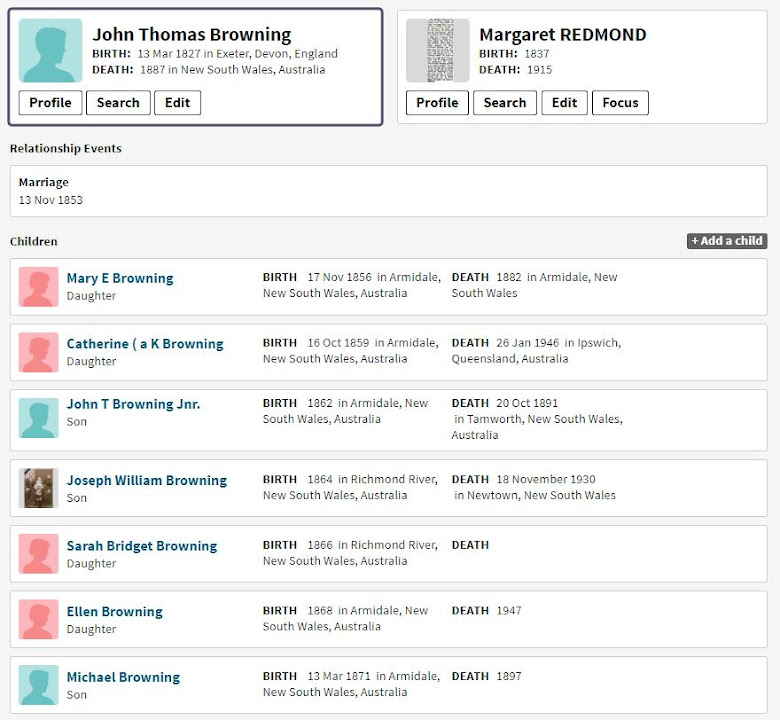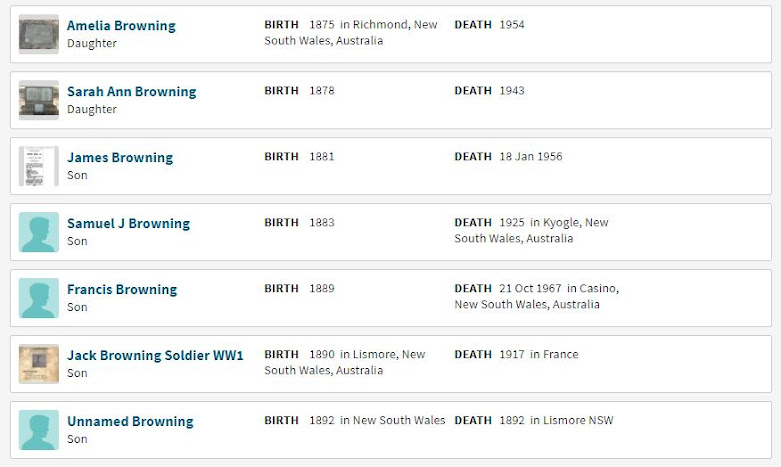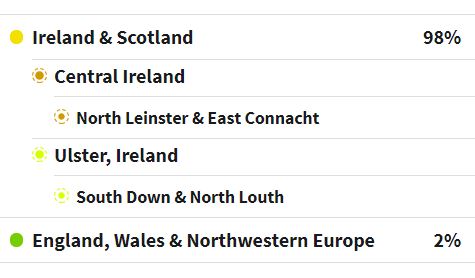I am only going to look at two successive generations in this post however. Those are the generations for which I have the most information and records, thanks not only to various extended relatives' related trees on Ancestry.com but also to Esme Smith and her valuable book "The Browning Story: Tracings from the Past", published in 2001.
My 3x great grandparents, William Henry Browning and Anne (known as Nancy) Littlejohns emigrated to Australia in 1840 from England, and they went on to establish the Browning line across the north-eastern region of New South Wales, which has grown to be quite vast in number.
William and Anne had 11 children and 95 grandchildren.
These are William's and Anne's children, (my 3x great aunts and uncles and 2x great grandmother):
Of those 11 children, 7 were born in England before William and Anne (Nancy) emigrated to Australia. Sadly, their daughter Dinah died two years before the family stepped onto the ship that bought them to Australia in 1840.
After arriving in the colonies, William and Anne (Nancy) went on to have another 5 children, although their last daughter Elizabeth only lived a month or so.
Out of the surviving 9 children, 7 then went on to have rather large families of their own (their offspring became my first cousins 3x removed, or my 2x great uncles and aunts, and my great grandfather):
Susannah Browning
Susannah married convict Joshua Craven in 1841 when she was 18 years old, but sadly died just two years later. They did not have any children.
Hannah Browning
Hannah married Thomas Norton in 1842 when she was 16 years old. They had a daughter named Mary Anne. Unfortunately Hannah's first husband Thomas died four years later and Hannah became a widow at age 21.
She re-married in 1848 and she and her second husband, Frederick James Wright, went on to have 17 children, including four sets of twins. Yes! You read that correctly!
After Hannah's marriage to her second husband, Frederick, she gave birth to twins James and Jane Caroline.
The twins were followed by Emily, William, Hannah, Matilda, Charles, Alfred and Harriet.
Then in 1862, Hannah gave birth to another set of twins, Joseph and Francis. Sadly they both died shortly after their birth.
Hannah then lost another baby in 1863. It appears her son was still born.
A year later, Hannah gave birth to her third set of twins, Thomas and Matthew, who both died shortly after their birth as well.
I can't imagine the heartache suffered by Hannah after losing five children within three years! How does a mother cope with such loss?
In 1865, just a year after the loss of her third set of twins, Hannah gave birth to Catherine; and the two years later, in 1867, Hannah gave birth to another set of twins, Sarah and Arthur. Sarah tragically died within a year, but Arthur lived a long life.
Interestingly, when Hannah's second husband Frederick died in a tragic accident in 1875, a newspaper article about the death inquiry stated that Frederick was the father of 21 children!!
If that was correct (and I'm including Frederick'a stepdaughter Mary Anne in that number), then perhaps Hannah lost three other children during their marriage or Frederick had children from a previous relationship. I have found no evidence for either of these possibilities though.
The newspaper article also stated there were 14 children still alive when he died in 1875, but my information shows only 10 children still living - Mary Anne (his stepdaughter), Jane, Emily, William, Hannah, Matilda, Charles, Alfred, Harriet and Arthur.
Perhaps the facts reported were exaggerated. My research indicates Hannah and Frederick only had a family of 18 and that by the time Frederick had died, there were 10 surviving children.
Hannah was 50 years old when her second husband died. She re-married in 1882 when she was 57 years old, but sadly Hannah passed away just eight months later. When Hannah died, she was survived by nine of her children, as her second-eldest daughter Jane had died just the year before.
John Thomas Browning
John married Margaret Redmond when he was 26 years old and she was 16. They went on to have a family of 13 children, including one set of twins.
John and Margaret moved around a lot in the early years of their marriage, as John spent many of these years working as a cedar cutter.
Around the time that their last child was born, Margaret filed for desertion and failure on John's part for maintaining her and the children.
It seems that John had indeed left his wife and family and sadly he ended up in Bathurst gaol in 1887, committed for lunacy, and died there.
He was survived by his wife Margaret and eleven of his children. Margaret went on to marry John Maker when she was 63 years of age. No, they didn't have any children!
Caroline Penelope Browning (my 2x great grandmother)
Caroline Penelope Browning married Henry Johnson Brown when she was 15 years old and he was aged 25. They had 12 children together.
Caroline and Henry began their nomadic married and working life on Runnymede Station, then Lismore Station before leaving the Richmond River area and moving north to the Northern Tablelands.
There they worked on Maryland Station for just a couple of years before returning to the Richmond River. At this time Henry began working as a timber dealer, cutting and selling cedar north of Lismore and family life became more settled.
Caroline's first husband, Henry Brown, died in 1868 when she was only 38 years old and she had children ranging from 20 years old to a baby of 18 months.
Caroline re-married in 1874, but sadly her second husband, Nathan Taylor, died just two months after their wedding.
Four years later, Caroline re-married again in 1878. This time she married Thomas Collins, but was left a widow once more three years later.
Caroline did not have any children with her second or third husband. She died in 1894 at the age of 64 and was survived by ten of her children.
William Henry (Bill) Browning
William Henry, known as Bill, married Sarah Jane Chillingworth in 1855 when he was 22 years old and she was 15. They went on to have 9 children.
Sadly Bill and Sarah lost their son named Francis Ernest in 1891, when he accidentally shot himself while reloading cartridges in his gun. He was only 15 years old.
The following year their son Henry Herbert died aged 20. His death was recorded as the result of phthisis asthenia. Two years later, Bill and Sarah's daughter Ann Eliza died of asthenia pulmonary phthisis, when she was 24 years old. Both these children appear to have life-threatening conditions that affected their lungs.
Bill died in 1905 when he was 73 years old. He was survived by his wife Sarah and four of his children.
Mary Anne Browning
Mary Anne married in 1853 when she was 16 years old. She married convict Charles Bustard (who also used the name Bostock) who was 35 years old. They went on to have 11 children.
Mary Anne's first husband Charles died in 1884 when Mary Anne was just 47 years old. She re-married sixteen years later, in 1898, when she was 61 years old. Sadly her second husband, John Cloughessy died just three years later. Mary Anne herself passed away in 1909 at the age of 71. She was survived by nine of her children.
James Francis Browning
James married Eliza Kennewell in 1873 when he was 32 years old and she was 26. They had a family of 12 children, including one set of twins.
James's wife Eliza died when he was 53 years old. James was to live for almost twenty more years, passing away in 1914, aged 72. He was survived by at least six of his children.
Joseph Edward Browning
Joseph married Elizabeth Wilson in 1863. He was 18 years old and she was 17. So young! They were married for 56 years, as Joseph died in 1919. They had 12 children.
Their daughter Mary died just days after being born. Their son Joseph died when he was only 6 years old. Their last son did not survive his birth. Their second youngest son Jack went off to fight in WW1 when he was 25 years old and was killed in action in France within two years.
Joseph died in 1919 at the age of 74. He was survived by his wife and eight of his children. His wife Elizabeth, known as Eliza, had this verse inscribed on this headstone:
"You are always in my thoughts dear husband,
Tis sweet to breathe your name.
In life I loved you dearly,
In death I do the same."
Matthew Browning
Matthew was the last child of William and Anne (known as Nancy). He married Ann Kennewell in 1874 when he was 27 years old and she was 29. Ann was Matthew's sister-in-law. Her sister Eliza had married Matthew's older brother James just the year before.
Matthew and Ann went on to have 8 children.
Matthew died in 1919, aged 72. His wife Ann had died just eight months before. They were survived by all of their children, who went on to live long lives. Theodore (Ted) lived until he was 67. Nancy Eliza lived until she was 64. William Francis lived until he reached the age of 75. John Thomas, known as Jack, lived until he was 72. James Littlejohn lived until 75 years of age. Sarah Theresa reached the age of 53. Charles Reuben lived until he was 56, and Margaret Alice lived until she was 73 years old.
As a large family unit, the Brownings were very close and very supportive of each other. They often lived and worked in the same places, or places quite nearby. They were there for the family weddings and baptisms, and got together to mark the passing of relatives.
I only have a few old photos of the Browning clan:
Children of my 3x great grandparents William Browning and Anne (known as Nancy) Littlejohns:
L-R: my 3x great aunt Mary Anne Bustard nee Browning; my 2x great grandmother Caroline Penelope Brown nee Browning; and my 3x great uncle Matthew Browning.
Grandchildren of my 3x great grandparents William and Anne (my first cousins 3x removed, my second great uncles and aunts, and my great grandfather):
Children of Mary Ann Bustard nee Browning and her husband Charles Bustard (also Bostock) - my first cousins 3x removed.
L-R: Margaret Jane Brown nee Bustard; Martha Ann Reeves nee Bustard; Thomas Charles Bustard (and his wife Gertrude); and Sarah Ann Smith nee Bustard.
Children of Hannah Norton / Wright / Carr and her second husband Frederick James Wright, (my first cousins 3x removed).
L-R: William Edward Wright; Harriet Matilda Thomas nee Wright.
The second eldest son of John Thomas Browning and his wife Margaret Redmond (my first cousin 3x removed).
Joseph William Browning, his wife Ellen Frances Redmond and their daughters.
Children of my 2x great grandmother Caroline Penelope Browning and her husband, my 2x great grandfather Henry Johnson Brown (my 2x great uncles and aunts, and my great grandfather).
Alexander Johnson Brown, known as Sandy Brown.
L-r: James Irving Clark Stevenson Brown and Eliza Duncan Gall nee Brown.
L-R: John Thomas Brown, my great grandfather Richard Joseph Brown, and William Norman Brown.
Children of William Henry Browning (known as Bill) and wife Sarah Jane Chillingworth (my first cousins 3x removed).
L-R: Caroline Maria Kean nee Browning, William Henry Browning (with his mother Sarah Jane Chillingworth), Arthur John Browning and his wife Mary Ann.
Son of Joseph Edward Browning and his wife Elizabeth Wilson (known as Eliza).
Jack Browning (my first cousin 3x removed).
Children of Matthew Browning and his wife Ann Kennewell (my first cousins 3x removed).
Nancy Eliza Robertson nee Browning.
L-R: John Thomas (known as Jack) Browning, and William Francis Browning.
L-R: Margaret Alice White nee Browning, and Charles Reuben Browning.
The common ancestors I share with all these people are the parents of the couple William Henry Browning and Anne (known as Nancy) Littlejohns, who emigrated to Australia:
John Browning 1770-1820 and wife Elizabeth Jackett 1762-1826
(both from Cornwall in England)
John Littlejohns 1772-1840 and wife Mary Ayears 1770-1858
(both from Devon in England)


































































